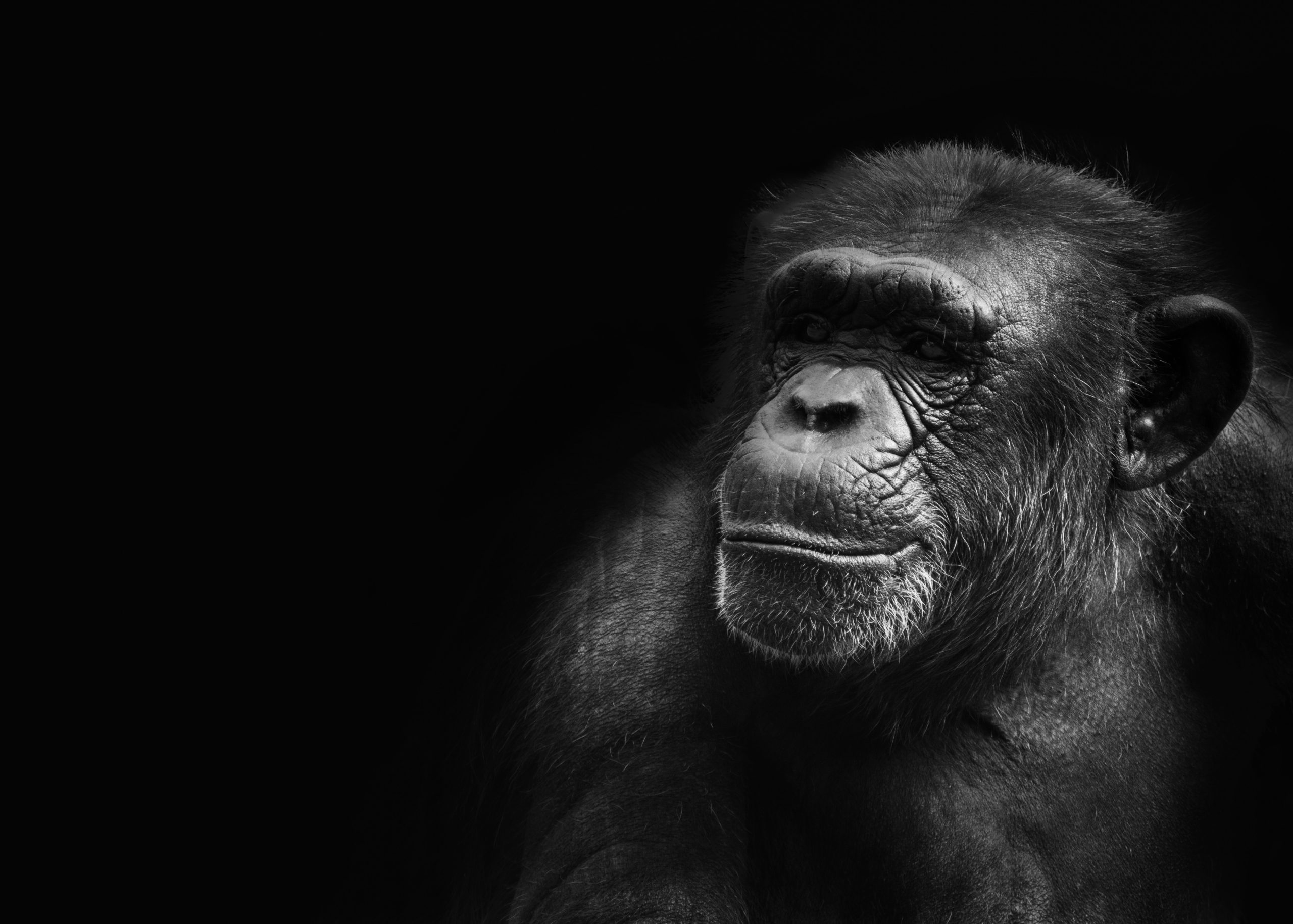Why we speak and chimpanzees don’t
Author: Beatriz Gómez-Vidal is a predoctoral researcher at the University of the Basque Country, Dep. Of Linguistics and Basque Studies (UPV/EHU) and member of The Bilingual Mind Research Group (Gogo Elebiduna)


Imagine this: you’re visiting the chimpanzee enclosure at a zoo. Some sit on the grass, chewing on leaves and scratching their heads, while others hang from the wooden beams. In a corner, a female is holding her baby. You can’t help but picture a human mom doing it in the exact same way. For a brief moment, you lock eyes with her, and you notice something special. Something eerily human. So much so that you could almost imagine her talking. But instead, all you hear is hooting, and grunting, and screaming. No words.
And so you wonder: how come we speak, and they don’t?
If you’ve ever asked yourself this question, you are not alone. In fact, scientists from a wide variety of fields have spent almost a century wondering about the same thing. We now know that we share about 96% of our genetic makeup with chimpanzees [1], making them our closest living relatives among the great apes. And underneath all that fur, we truly are very much alike. Like us, chimpanzees engage in social play, create life-long bonds, and have close friends; they also prefer cooked food, are conscious of their own thoughts, and even smile socially [2–7].
And yet, when it comes to communication, it seems that we couldn’t be more different. Chimps use hoots, barks and grunts to communicate about a limited number of topics (i.e., food, interactions and danger) [8,9]. But not humans: instead, we have developed the rarest communication system on Earth. To the unsuspecting language user, this may seem like an overstatement, but it so isn’t. In language, we combine meaningless phonemes (or cheremes in sign language) into meaningful words, and then combine those words into sentences to produce a complex, structured meaning. And it is all-purpose too: we can talk about the dead, make up stories, hypothesize about the future or retell the events that transpired on a Wednesday.
Powerful, isn’t it? Yes, and very annoying. Because if our closest living relatives don’t have it, then where does language come from? How did it evolve? In essence, how come we speak and they don’t?
Well, the short answer is that we still don’t know exactly. The long answer is that it’s complicated and that the index finger is kind of the protagonist. Allow me to elaborate…
The humble act of pointing
The first mind-blowing fact you should know about this linguistic puzzle is that chimpanzees are not as languageless as they may seem. As it turns out, chimps raised by humans in linguistically-rich environments do develop some remarkable linguistic abilities [10,11]. Due to differences in vocal tract anatomy between us and them, captive apes were often instructed in sign language, a modality which allowed them to become skilled in both comprehension and production. Washoe, a female chimp raised by humans, was known to understand and use linguistic signs consistently to refer to objects or other animals, both in the presence of people and by herself. She also invented at least one new sign on her own, and she could make up new “words” by putting already known signs together to refer to a new object. For instance, she once called a Brazilian nut a “rock berry”, which is kind of brilliant—and descriptive!
Evidently, these studies have been nothing short of controversial. They were plagued by methodological and ethical concerns, and the fact that there were great differences between individual apes begs the question of how representative they were of their species’ abilities as a whole. However, you have to give it to them: it’s a fascinating discovery either way. The fact that great apes can learn some linguistic abilities suggests that they must possess some of the cognitive requirements necessary for language development, like understanding referentiality, meanings and compositional structure. Interestingly, new evidence has just been uncovered that shows wild chimpanzees combine individual calls into larger structures; this resembles the way syntax operates in human language [9]. So what is actually missing? What’s the secret ingredient that we so mysteriously possess? Well, some researchers believe that it could be boiled down to one very simple, and yet uniquely human gesture: the humble act of pointing.
No point in pointing for a chimpanzee
When you extend your index finger and demand another human’s attention to an object, you may think that you’re doing something quite simple. After all, even preverbal babies can do it [12,13]! And yet, as straightforward as it seems to us, pointing does not come as easily for our furry cousins. In fact, no other great ape has been documented to engage in pointing with other apes, neither in captivity nor in the wild [14,15], and experiments show that pointing is one of the human gestures that they just do not understand [14,15]. This is because chimps are not aware of another’s intention to communicate in pointing [12]. They can keep track of the goals and intentions of others rather nicely, like understanding that an outstretched arm means an intention to grab the object in front of it [12,14,15]. But it seems that they just can’t wrap their heads around the fact that another individual is intentionally trying to grab their attention to focus on the same thing together, even if there is nothing to gain for the individual who is doing the pointing.
Weird, isn’t it?
As it turns out, not so much, since there are many similarities between pointing and human language [12]. In both cases, a human is trying to communicate with another on the basis that the sign can be understood because of their common knowledge. Both in language and in pointing, we’re aware of the other’s intention to communicate, and because of this we place our attention on whatever the producer is drawing attention to. And so we both end up thinking about the same thing. It’s as if humans routinely engage in something like mind-reading with other humans. If you think about it, this is what you have been doing this whole time. You see, I know that you know that I typed these sentences to share some ideas with you, and that’s why, as you read, you keep synching up your thoughts with mine by retrieving the words I gave you in order to form those ideas in your own head. This is the way in which you have been mind-reading me—admittedly, with some delay—during the process of understanding this article. And you couldn’t have done if our ancestors hadn’t invented pointing first, which is hypothesized to have laid the groundwork for language in our species [12].
So now you know why your index finger seems to be the secret ingredient in the human recipe for communication. Behind it, there lay the most amazing artifacts of human cognition: our instinct to communicate intentionally, and our ability for mind-reading, which may well explain the century-long mystery of why we speak and chimpanzees don’t. So, the next time you catch yourself pointing at something, give it some credit and remember that it is this simple gesture what likely preceded the emergence of language in our species. One could even go as far as saying that, without our instinct for pointing, humanity as we know it might have never existed.
References
1. The Chimpanzee Sequencing and Analysis Consortium. Initial sequence of the chimpanzee genome and comparison with the human genome. Nature 2005;437(7055):69–87, doi:10.1038/nature04072.
2. Beran MJ, Perdue BM, Futch SE, Smith JD, Evans TA, Parrish AE. Go when you know: Chimpanzee’s confidence movements reflect their responses in a computerized memory task. Cognition 2015;142:236–46, doi:10.1016/j.cognition.2015.05.023.
3. Cordoni G, Palagi E. Ontogenetic trajectories of chimpanzee social play: Similarities with humans. PLoS ONE 2011;6(11):e27344, doi:10.1371/journal.pone.0027344.
4. Davila-Ross M, Jesus G, Osborne J, Bard KA. Chimpanzees (Pan troglodytes) produce the same types of ‘laugh faces’ when they emit laughter and when they are silent. PLoS ONE 2015;10(6):e0127337, doi:10.1371/journal.pone.0127337.
5. Fraser ON, Stahl D, Aureli F. Stress reduction through consolation in chimpanzees. Proceedings of the National Academy of Sciences 2008;105(25):8557–62, doi:10.1073/pnas.0804141105.
6. Massen JJM, Koski SE. Chimps of a feather sit together: Chimpanzee friendships are based on homophily in personality. Evolution and Human Behavior 2014;35(1):1–8, doi:10.1016/j.evolhumbehav.2013.08.008.
7. Warneken F, Rosati AG. Cognitive capacities for cooking in chimpanzees. Proceedings of the Royal Society B: Biological Sciences 2015;282(1809):20150229, doi:10.1098/rspb.2015.0229.
8. Slocombe KE, Lahiff NJ, Wilke C, Townsend SW. Chimpanzee vocal communication: What we know from the wild. Current Opinion in Behavioral Sciences 2022;46:101171, doi:10.1016/j.cobeha.2022.101171.
9. Leroux M, Schel AM, Wilke C, Chandia B, Zuberbühler K, Slocombe KE, et al. Call combinations and compositional processing in wild chimpanzees. Nat Commun 2023;14(1):2225, doi:10.1038/s41467-023-37816-y.
10. Sedivy J. Language in mind: An introduction to psycholinguistics. Sunderland, Massachusetts: Sinauer Associates, Inc; 2014.
11. Gibson KR. Language or protolanguage? A review of the ape language literature. In: Tallerman M, Gibson KR, editors. The Oxford Handbook of Language Evolution. Oxford: Oxford University Press; 2012, p. 46–58.
12. Tomasello M. Why don’t apes point? In: Enfield NJ, Levinson SC, editors. Roots of Human Sociality: Culture, cognition and interaction. Oxford, New York: Berg; 2006, p. 506–24.
13. Call J, Tomasello M. Does the chimpanzee have a theory of mind? 30 years later. Trends in Cognitive Sciences 2008;12(5):187–92, doi:10.1016/j.tics.2008.02.010.
14. Bräuer J, Call J, Tomasello M. Chimpanzees really know what others can see in a competitive situation. Anim Cogn 2007;10(4):439–48, doi:10.1007/s10071-007-0088-1.
15. Hare B, Tomasello M. Chimpanzees are more skillful in competitive than in cooperative cognitive tasks. Animal Behaviour 2004;68(3):571–81, doi:10.1016/j.anbehav.2003.11.011.
3 comments
How interesting! This could be a good example of gestural (or non-verbal) referential function of language. However, I’m afraid that it would be difficult to find a causative relationship between the act of finger pointing and the origin of language, or even that the first preceded the second.
Tal vez no sintieron la necesidad de diferenciar sonidos referidos a la comunicación de objetos diferentes. Otra perspectiva sería la de preguntarse porque, en esos chimpancés, se detuvo la evolución y otros llegaron al sapiens
Perhaps chimps dont have the concept for it, and grunt sounds are enough for differentiating the “whats” so they dont need complex sounds for the collection of things they grasp.
Could it be related to the concept of “I need you to do this to reach xyz outcome”?
Pointing appeals to require others to focus into something being pointed at, and do something with it, within a process. Differentiating the “what” maybe prompted phonemes, then words (and syntax delivery) in primitive humans (who might had grunts sounds too).
There must be a way to structure a process that exhausts the collection of things they use and forces them to look for cooperation in others, besides the transactional known things they already do.
Perhaps is a nested logic complexity problem, not a direct serial transactional one.